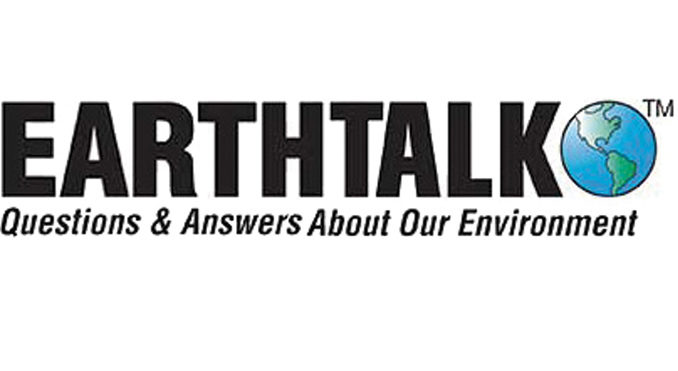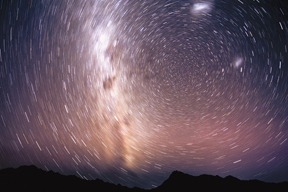
September 2021
Dear EarthTalk: How has all the wildfire smoke in the West over the last few summers impacted human health? And what can we do to stay safe amidst the smoke? ~ B.K., Philadelphia, PA
Blanketing the atmosphere with thick veils of black smoke and turning skies a hazy orange hue, wildfires have ravaged the Western U.S. as long as anyone can remember. Though wildfires are natural and a critical component of a healthy forest ecosystem, unusually large and lengthy fires have now become the norm across much of the American West.

The year 2020 was record-breaking for wildfires in the U.S. The August Complex fire in Northern California alone torched more than a million acres of land—making it the state’s first ever “gigafire.” And Californians are bracing for more. With temperatures rising around the globe due to climate change, wildfires have only expanded in size and hazard, raising widespread concerns over the impacts of the smoke and how to mitigate the negative health effects.
Wildfire-released pollutants pose many ecological threats, which in turn have both short- and long-term health hazards for nearby communities. Most troublesome may be the PM 2.5 particulate, given that it is small enough to enter the lungs as well as the bloodstream, potentially impacting both the cardiovascular and respiratory systems. In the short-term, these pollutants can lead to eye and nasal irritation, heart attacks and strokes, while longer term exposure can cause permanent damage to the heart and lungs.
While efforts in recent decades to reduce pollution from factories and automobiles have reduced the particulate pollution burden on Americans significantly, wildfires are bringing PM 2.5 levels back up into hazardous territory for many across the West, at least during wildfire season. Wildfire smoke also contains many other hazardous pollutants, like carbon monoxide and toxic ash, as well as carbon dioxide that contributes to global warming.
The more we know about the potential health impacts of wildfire smoke, the better we can protect ourselves and our loved ones. Wildfire pollution can circulate in the atmosphere for weeks. During the warmer months, consistently check local air-quality reports and read visibility guides before heading outdoors. If you have to go outside in smoky summer weather, wear an N95 mask, which filters most PM 2.5 particulates. However, health-sensitive groups are always at a risk, even with N95 masks. If the surrounding air quality is rated hazardous, everyone should avoid the outdoors as much as possible and take preventive steps like installing an air filter indoors.
If you live in the West (or anywhere arid) and are hoping for a reprieve from smoky skies this summer, don’t hold your breath. According to scientists at San Jose State University, 2021 is looking to be an even worse year for wildfires than last year’s record breaker due to excessively low levels of winter moisture across much of the West. The upshot seems to be that we better just get used to it.
CONTACTS: Silent calamity: The health impacts of wildfire smoke, https://yaleclimateconnections.org/2021/05/silent-calamity-the-health-impacts-of-wildfire-smoke; Could Wildfires Have Long-Term Health Effects? webmd.com/lung/news/20200925/could-wildfires-have-long-term-health-effects; Health effects of wildfire smoke in children and public health tools: a narrative review, nature.com/articles/s41370-020-00267-4; CDC’s Wildfire Smoke Info, cdc.gov/disasters/wildfires/smoke.html.
Dear EarthTalk: What are “dark sky havens” and are there any near me? ~ D. Morris, Troy, MI
A bright moon hangs over the clear, terrestrial night sky permeated by winking stars, illuminating the town below with various hues of blue. While some can only fantasize of these beautiful night settings, these nighttime skies do in fact exist—in what is commonly known as “dark sky havens.”
In considering the necessity of these dark sky havens, we must first examine why most night skies are not all like this in the first place. In most populated, industrialized areas, artificial light from sources ranging from streetlights to factories to commercial properties cause intensive light pollution—casting a dusky yellow stain over the sky’s natural glow. This excessive artificial light cannot only harm wildlife and the earth’s atmosphere, but also people. For example, blue LED light can disrupt sleep rhythm and increase risk of cardiovascular disease and cancer, according to the American Medical Association. Thus, many environmental advocates have pushed for state-level legislation on limiting artificial light, particularly in places like Colorado.
In addition to local legislation to restrict light pollution, acquiring a dark sky status requires direct effort from an entire community. While local governments need to measure light levels regularly and curtail public lights, community residents must reduce their own light usage—especially for any outdoor lighting that can spread to other properties. On a wider scale, residents can implement smarter, greener lighting with LED technology, which can reduce both your electricity bill and carbon footprint by maximizing energy efficiency, which consequently lowers greenhouse gas emissions from power plants.
Reducing light pollution and creating dark sky havens can be important elements in environmental preservation, economic development and public health. In many rural areas, dark sky initiatives promote tourism for stargazing and meteor-shower watching—luring more visitors and thus more money. Even more, preserving natural nighttime darkness is a worthwhile investment for public well-being. “A view of the night sky can soothe the soul,” says John Barentine, astronomer and policy director of International Dark-Sky Association. “In an era when so many people are suffering from the sensory overload of modern life, as well as what psychologists are calling ‘nature deficit syndrome,’ the night sky offers calm, quiet contemplation.”

Though the International Dark-Sky Association’s standards for managing artificial light are high and certification can take years, dark sky zone applications have expanded widely in Colorado, including the towns of Crestone, Cuchara, Paonia, Pagosa Springs, Naturita, Nucla and La Veta. In the surrounding Rocky Mountain region, towns in states like Arizona, Idaho, Montana, Nevada, New Mexico, Utah, and Wyoming have filed at least 10 applications for dark sky certification. Along with the 25 dark sky towns in the U.S. that you can visit, there are also 77 dark sky designated parks around the nation where you can lay out a blanket after sunset and bask in the nocturnal wonders of starry nights.
CONTACTS: International Dark-Sky Association, darksky.org;“In rural Colorado, a growing push to preserve dark skies as artificial light spills out of cities,” denverpost.com/2021/05/29/dark-sky-towns-colorado-light-pollution-environment/; “Four more Colorado towns certified as “dark sky” havens,” denverpost.com/2021/01/17/colorado-dark-skies-preservation/.
Dear EarthTalk: Are the new SST jets friendlier to the environment than the SSTs of the 1970s? ~ P. Barnes, Midlothian, TX
Nearly 20 years have passed since the last flight of the Concorde, the first supersonic passenger-carrying commercial airplane (or supersonic transport, SST). The aircraft cruised the Queen of England and the ultra-wealthy across the seas at Mach 2 speed, or 1,350 mph, while soaring at an altitude of 60,000 feet. In 1996, the Concorde achieved its fastest flight from New York to London in under three hours.

Now a new wave of supersonic flight may be on the horizon with the recent partnership between United Airlines and Denver-based Boom Supersonic. In June 2021, United Airlines announced plans to purchase 15 of Boom Supersonic’s first commercial supersonic jet, the Overture. Boom plans to engineer the Overture to fly up to 88 passengers at a speed of Mach 1.7, or 1,300 mph, at 60,000 feet. Most flight times will be cut nearly in half: Traveling from Paris to Montreal will only take three hours and 45 minutes instead of the usual eight and a half hours; a trip from San Francisco to Tokyo take just six hours rather than the usual 10 hours and 15 minutes.
Boom and United plan a modern, economically-viable, ecologically-sustainable version of the old Concorde, which was “a ludicrously expensive environmental disaster,” according to the International Council on Clean Transportation. “It helps to remember that we’re talking literally about 1960s technology,” Boom Supersonic’s Founder Blake Scholl told CNN Travel. “So much has changed.”
In collaboration with Prometheus Fuels, a California-based company, Boom plans to design a 100 percent carbon-neutral plane powered by sustainable alternative fuels. The company claims that Prometheus’ technology is able to economically remove CO2 from the air and use renewable, clean electricity from solar and wind to turn it into jet fuel. After successfully running their XB-1 test engines with a blend of more than 80 percent sustainable aviation fuel, Boom has confidence that sustainable fuels can safely be used in flight. If all goes as planned, the Overture may be flying passengers as soon as 2029.
Virgin Galactic is also throwing its hat into the ring of supersonic commercial air travel. In August of 2020, the company unveiled plans to collaborate with Rolls Royce in developing sustainable commercial high-speed aircraft capable of an astonishing Mach 3, or approximately 2,300 mph. The smaller-scale aircraft will hold 9-19 passengers and utilize state-of-the-art sustainable aviation fuel and “other sustainable technologies and techniques.”
Aerion Supersonic, which publicized plans last year to build a $375 million manufacturing facility at Florida’s Orlando Melbourne International Airport, also expressed its commitment to having carbon neutral emissions and designing their aircraft to run on 100 percent sustainable aviation fuels. However, due to financial challenges, the company announced in May 2021 that it will not be able to move forward with the facility at this time.
CONTACTS: Kirby your enthusiasm about the supposed supersonic revival, theicct.org/blog/staff/supposed-supersonic-revival-jun2021; United Airlines will buy 15 ultrafast airplanes from start-up Boom Supersonic, cnbc.com/2021/06/03/united-will-buy-15-ultrafast-airplanes-from-start-up-boom-supersonic.html; Boom Supersonic Announces First Fully Carbon-Neutral Aircraft Program, XB-1, boomsupersonic.com/news/post/carbon-neutral-aircraft.
EarthTalk® is produced by Roddy Scheer & Doug Moss for the 501(c)3 nonprofit EarthTalk. See more at https://emagazine.com. To donate, visit https//earthtalk.org. Send questions to: question@earthtalk.org.

